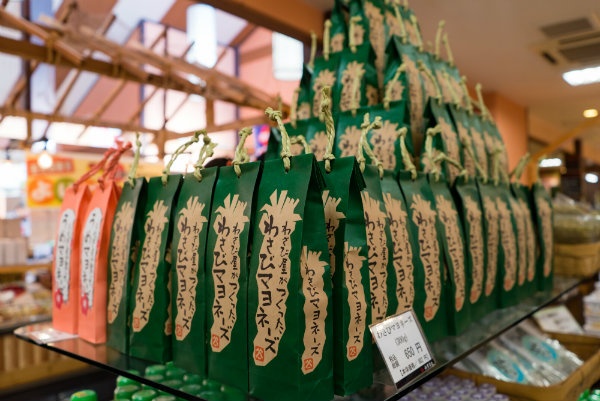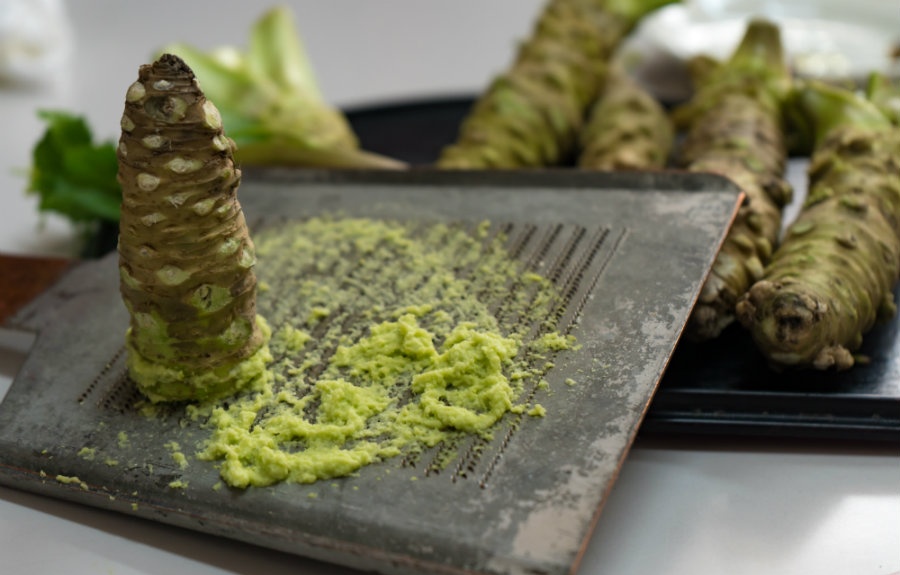Wasabi—Japan’s Fiery, Flavorful Root
If you’ve eaten sushi or sashimi, you’ve no doubt tasted wasabi. The wasabi that grows along the mountain streams in each region of Japan has long been known as a medicinal agent, said to have been used for its antibacterial and deodorizing effects since as early as the Asuka Period (592-710).
By Highlighting Japan
http://www.gov-online.go.jp/eng/publicity/book/hlj/html/201603/201603_12_en.html
Tokugawa Ieyasu, famed epicure and first shogun of the Edo Period (1603-1868), loved this seasoning, and is said to have carefully proscribed its cultivation. The region he entrusted its production to was Shizuoka Prefecture.
80 percent of the wasabi shipped to Japanese markets is now cultivated in Shizuoka Prefecture—and the Izu Peninsula stands as Shizuoka’s greatest wasabi-producing region. With its characteristic warm climate, the peninsula is known as a home of hot springs and resorts where visitors can enjoy a variety of marine sports.
https://www.youtube.com/watch?v=rCAMiHHrroY&feature=youtu.be
The land here is mountainous, explains wasabi farmer Hirotsugu Shioya, who tends a steep, terraced plot overlooking Izu City. The scent is of earth meeting rushing water in the cold mountain air, and green sprouts of various sizes spread out across watery paddies up and down the hillside. The greenery is divided by spindly trails that look almost wide enough for a goat, but prove wide enough to support nimble farmers examining their plants.
“Wasabi is really dependent on water, the air and the environment,” says Shioya. The water here is incredibly clean and fresh, and wasabi grown in Shizuoka use all the blessings of nature, such as the runoff from Mount Fuji. Another challenge to raising the finicky crop is the time required: anywhere from a year and a half to two years for the plant to grow big enough to harvest.

http://www.gov-online.go.jp/eng/publicity/book/hlj/html/201603/201603_12_en.html
Back at the foot of the mountain at the Izu Agriculture Research Center, fourth- and fifth-generation wasabi farmers congregate to talk shop. When pressed, they share some of their favorite ways to eat the plant. Several mention wasabi-don, which is made by mixing wasabi with soy sauce and shaved bonito on top of rice. Others like it with grilled meat, while one reminisces about how his grandfather put it in the breakfast miso soup. Another says he relishes “negi-toro (scallions and fatty tuna) with plenty of wasabi—and a good cry.”

http://www.gov-online.go.jp/eng/publicity/book/hlj/html/201603/201603_12_en.html
Further along the road toward Mount Fuji is the Mishima Wasabi Factory, a bazaar dedicated to wasabi that’s popular with daytrippers. The Mishima Wasabi Factory is also the company store of Yamamoto Foods, a purveyor of Shizuoka wasabi products. Fourth-generation president Yutaka Yamamoto wants visitors to experience Izu and, more specifically, wasabi. “Wasabi can be used in various interesting and delicious dishes,” says Isao Yamamoto, Yutaka’s brother. “You can enjoy it not only with sashimi, but also with meat, cheese and other foods.” Their most popular products include wasabi mayonnaise, wasabi shrimp crackers, and an oil-based seasoning made from wasabi powder in olive oil.
Although the whole plant is spicy, the part most often used to produce the familiar green paste is the rhizome, which serves as the plant’s stem. And there’s a specific way to grind it, Yutaka explains. First you should strip the leaves off the top rather than lopping them off, which preserves the precious, tasty, sharp-scented part. Then use a quality grinder such as shark skin, preferably one made specifically for wasabi; a fine grinding surface will produce a silkier paste, while a coarser one will produce a grittier result. Finally, he says, you must “grind slowly, in a circular motion, with a smile.” It may sound funny, but he says that’s essential, because grinding while calm and happy will mean a lighter and gentler touch, while grinding in haste or anger will yield sloppy, haphazard results.
https://www.youtube.com/watch?v=39Y9f_P2DpA&feature=youtu.be
Next up is Shizuoka’s neighboring wasabi-producing prefecture, Nagano. Boasting nature on a grand scale, Nagano can be accessed from Tokyo within an hour and a half by bullet train, drawing crowds of people seeking to fill their days off with skiing, hot springs or hiking.
Read the rest at Highlighting Japan below!




